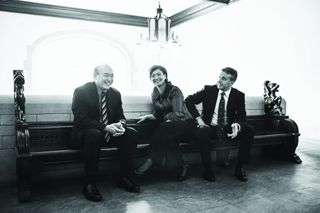|
Back
Whirling birds, rafter rattling Tchaikovsky Ottawa
Southam Hall, National Arts Centre
05/06/2015 - & May 7, 2015
Wolfgang Amadeus Mozart: Le nozze di Figaro, K. 492: Overture
Jordan Pal: Starling: Triple Concerto
Piotr Ilyich Tchaikovsky: Symphony No. 4 in F minor, Op. 36
Gryphon Trio: James Parker (piano), Annalee Patipatanakoon (violin), Roman Borys (cello)
National Arts Centre Orchestra, Edwin Outwater (conductor)

The Gryphon Trio (© Daniel Ehrenworth)
It was an evening of high ambition and a couple of surprises for the National Arts Centre Orchestra (NACO) this week. Surprise number one was that guest conductor Xian Zhang was indisposed and, on very short notice, was replaced by Edwin Outwater, music director of Ontario’s Kitchener-Waterloo Symphony. The second surprise was that Canadian composer Jordan Pal’s Starling: Triple Concerto for Violin, Cello, Piano and Orchestra was a marked, almost total contrast to the composer’s single movement tone poem, the afar, performed here last July by Canada’s National Youth Orchestra. While the afar was an austere, almost brutalist yet dryly sensual work in a single movement, Pal’s Triple Concerto (commissioned by The Gryphon Trio and the Thunder Bay Symphony and premiered by them in March, 2013) was, for all its exotic orchestration and ingenious melding of structure and impressionism, a much more conventional, though genuinely compelling work – in this instance, a three movement Concerto with formal and structural roots in Beethoven’s masterpiece of the same name and form.
What came across loud and clear (literally and metaphorically) is that Pal is a young composer of genuine range and versatility. He has his own vision and voice, for sure, however has learned at an early age to adapt to a range of work contexts and is doing so with the skill and aplomb of a veteran. Explaining the Concerto’s title Starling, Pal states the work is “reminiscent of flocking starlings performing breathtaking, whirling aerial displays as they prepare to roost for the winter....” This provides a solid overall clue to the work – though the winter reference may have been problematic for some Ottawa listeners, now emerging from possibly the most brutal winter on record – and to its scoring which makes minimal use of the orchestra’s brass section. The three movements are an ongoing dialog among the three soloists and the orchestra’s various sections, with high register conversations amongst piano trills, concurrent woodwind trills, percussion (including a wind machine), cello often in very high register and violin in all registers. The writing was sometimes a tad obvious (as many piano glissandi as one might have expected from a Liberace show), though this was clearly deliberate and added wit to the sonic palette. If there’s a challenge with this work (especially for a conductor) it would be to reconcile the ingeniously impressionistic audio spectrum with the more straightforward structural elements. The second movement, Largo nobile is virtually a single, sustained crescendo with blocks of sound redolent of the afar.
It’s a tribute to conductor Edwin Outwater that he was able to unify the work so strongly, and further speaks volumes for the orchestra which met the challenge of a complex, demanding new work with both panache and finesse. And the playing of The Gryphon Trio was consistently stellar, especially the work of cellist Roman Borys.
The concert had opened with Mozart’s Overture to The Marriage of Figaro, given a generic ‘egg timer’ performance. With its playful elements and classical structure, it proved a fitting prelude to Pal’s Triple Concerto.
The evening’s second half was a brilliant reading of Tchaikovsky’s Symphony No. 4. This was his breakthrough Symphony, a work which established, indeed catapulted Tchaikovsky into the ongoing mainstream of predominantly German symphonic composers. Picking up from Beethoven in ‘Eroica’ mode, and setting the stage for Mahler (whose Symphony No. 9 was directly modeled on Tchaikovsky’s Symphony No. 6) Tchaikovsky fashioned a masterpiece of unprecedented orchestration, taut structure, and psychological torment, though the work is never indulgent or excessive. The strings’ sheer pianissimos in the first movement’s second subject, then pizzicato in the ingenious Scherzo were among the reading’s many riches.
Again, Edwin Outwater led the NACO players through a performance that rattled the rafters, yet never lost control, technically or emotionally, and brought the entire audience, and his players, to their feet. This was an evening of brilliance, virtuosity and contrasts.
Charles Pope Jr.
|